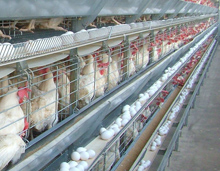On farm test to early detect Salmonella

The US Centers for Disease Control and Prevention estimates, each year, about 9.4 million people get sick from contaminated food. A new test may detect Salmonella infection in an early stage, allowing prompt action.
The USDA reports the leading cause of bacterial-related food illness in the U.S. is salmonella. About one million Americans get sick from salmonella annually, more than 19,000 are hospitalized and more than 370 people die. The annual cost of medical treatment for salmonella-related food illness is $365 million.
The CDC estimates that eggs and poultry account for nearly half (47 percent) of all foods associated with salmonella outbreaks. Salmonella bacteria in the housing environment can contaminate the outer shell of the eggs or get inside through pores in the egg’s shell. More importantly, chickens can carry the bacteria in their digestive tract.
To reduce the risk for widespread infections, the Food and Drug Administration now requires egg producers with 50,000 or more birds to test the eggs and animal environment for salmonella contamination. These regulations took effect on July 10, 2010. Producers of smaller flocks will be required to adhere to the guidelines by July 9, 2012.
Shelley Rankin, microbiologist with the University of Pennsylvania School of Veterinary Medicine in Kennett Square, PA says the traditional test for salmonella bacteria in poultry houses and eggs is very effective, but takes about 10 days to get results. By that time, if the tests have come back positive for salmonella, the eggs have typically reached consumers. Producers must then issue a recall.
A new test, called the TaqMan detection kit, can be used to test both the hen house environment and egg. More importantly, the results are available within 48 hours. The hope is, with the faster turn around time, contaminated eggs can be kept out of the food supply, greatly reducing the risk for illness among consumers.
Rankin explains the environmental part of the test involves dragging a prepared gauze pad through the animal manure (because the bacteria will be excreted in the bird feces). If the manure tests positive for the bacteria, the eggs are also tested. That requires taking a sampling of at least 20 disinfected eggs, cracking the shells, mixing the contents to break the yolks and testing the solution. If salmonella is found in the eggs, they are sent to a pasteurization plant. That process heats the eggs and kills the bacteria, making the eggs safe to eat.
Source: WSOCTV.com












